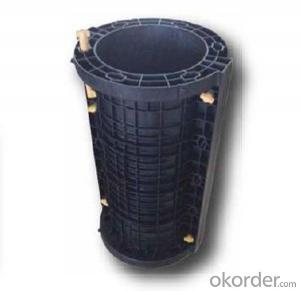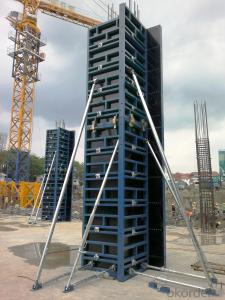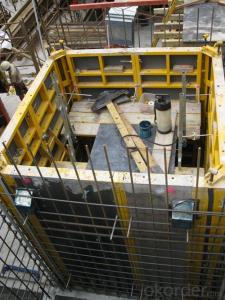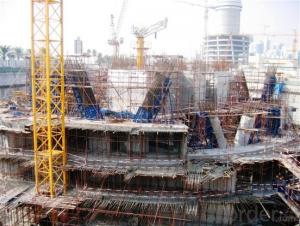Aluminum Scaffolding Beam Formwork Scaffolding Base Plate New Design
- Loading Port:
- Tianjin
- Payment Terms:
- TT OR LC
- Min Order Qty:
- 10000 set
- Supply Capability:
- 50000 set/month
OKorder Service Pledge
OKorder Financial Service
You Might Also Like
Aluminum Scaffolding Beam Formwork Scaffolding Base Plate New Design
Plastic Formwork Concrete Formwork Fiberglass Scaffolding Japan Standard Scaffolding Made in China
Developing with new technology materials, steel formworks is no longer a must in construction concrete process. More and more buildings are established with plastic formworks. And workers love this new formworks much more.
The advantages of plastic formworks:
Aluminum Scaffolding Beam Formwork Scaffolding Base Plate New Design
1.First of all--light
Yes it is the first advantage of plastic formwork. It wins the great praise of both contractors and workers.
The biggest panel is 120×1500px,weights 10.5kg only. It can be lift and set up by one person easily, which means there is no need for cranes on site.Saves a lot of cost and time.
2.Easy set up
Different size of panels can firmly locked by simply turn the special handles to 90 degree. The Panels has rib on the back, which makes the system need not traditional wood blocks and nails. The panels have holes to fit tie rod, guarantee the strength of the whole system.
3.Modularity
Modular formworks composed by different size of panels,the main item is 120×1500px panel,which is used for the large area of walls and slabs. There are also small size of panels like 10×1500px,20×1500pxcm,25×1500px,inner corner 20×20×1500px and outer corner 10×5×1500px.Due to the variety of panel size, the system can form almost all size walls 120×1500px panel of multiply by 125px. The material of modular formwork is PC-ABS mixed with special glass fibers which enable panels to hold high pressures.
4.Strength
The handles are made by high strength Nilon, each panel locked by at least 4 handles, which makes the whole system strong enough to pour 1000px walls. Aluminum Scaffolding Beam Formwork Scaffolding Base Plate New Design
* Good loading capacity
* Easy to assemble and dismantle
* Stable and durable thanks to its structual design & automatic welding quality
Aluminum Scaffolding Beam Formwork Scaffolding Base Plate New Design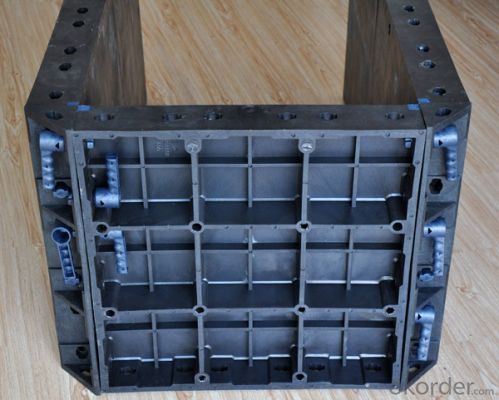
Aluminum Scaffolding Beam Formwork Scaffolding Base Plate New Design
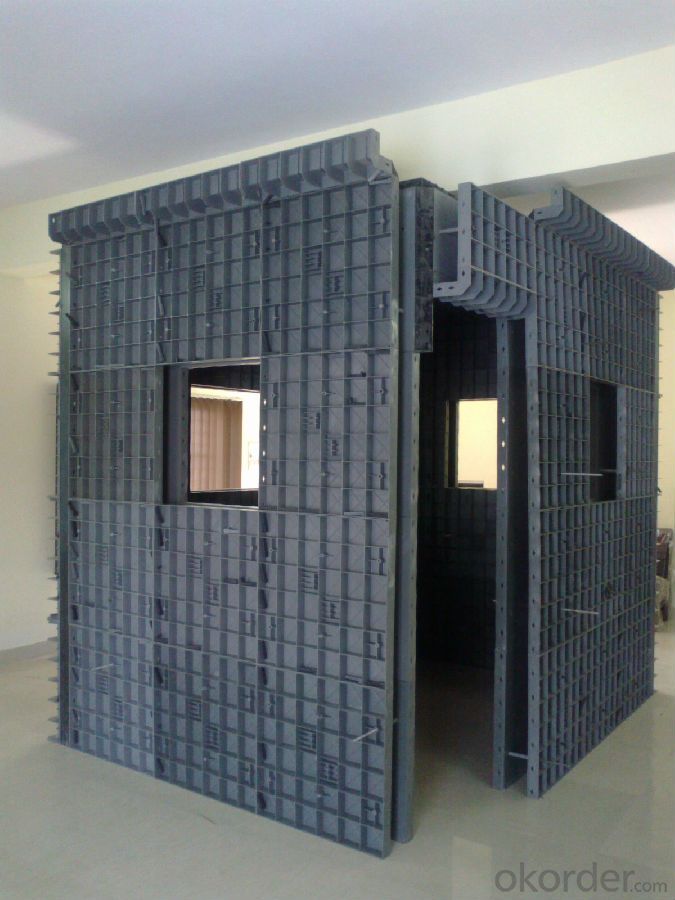

FAQ
We have organized several common questions for our clients,may help you sincerely:
Why Us?
We are one of the Top 500 in the world, largest construction materials supplier in China. Also we are a state-owned company and respond to every customer with large and also small orders.
We own professional manufacturers with powerful producing capacity.
Extensive and comprehensive quality control system
- Q:Can steel frame formwork be adjusted to different sizes and shapes?
- Steel frame formwork has the ability to adapt to various sizes and shapes. It is a versatile construction tool that can be easily adjusted and customized. By assembling and disassembling the frames, different dimensions and shapes can be accommodated for different construction projects. This flexibility enables the construction of walls, columns, beams, and other structural elements of different sizes and shapes. Furthermore, steel frame formwork can be combined with other formwork systems to enhance its adaptability even more, making it a popular choice among construction professionals.
- Q:How does steel frame formwork handle concrete pouring and vibration?
- The effective handling of the concrete pouring and vibration process is achieved through the use of specially designed steel frame formwork. This formwork employs a rigid structure, acting as a support for the weight of the fresh concrete and facilitating the desired formwork configurations. To maintain stability and prevent any movement or displacement during concrete pouring, the steel frame formwork is securely fixed in position. This is essential for preserving the integrity and accuracy of the final structure. The steel frame offers a sturdy framework, enabling the smooth and efficient pouring of concrete. In terms of vibration, the steel frame formwork is engineered to withstand the forces generated during this process. Vibration is crucial for eliminating air pockets or voids within the concrete, ensuring a durable end product. By absorbing and distributing the vibration energy, the steel frame formwork prevents any deformation or damage to the structure. Furthermore, the steel frame formwork often incorporates additional features to enhance the concrete pouring and vibration process. These may include adjustable leveling devices, tie rods, and clamps, which provide extra support and stability. This allows for precise control over the pouring and vibration, resulting in a high-quality concrete structure. Overall, the steel frame formwork is specifically designed to handle the challenging conditions of concrete pouring and vibration. Its strong construction and advanced features offer the necessary strength, stability, and control required for a successful and efficient concrete construction process.
- Q:How does steel frame formwork accommodate for changes in concrete thickness?
- The steel frame formwork system is designed to be flexible and adjustable, allowing for modifications in the thickness of the concrete throughout the construction process. It is comprised of steel panels and beams that can be effortlessly repositioned or altered to accommodate different concrete thicknesses. This is accomplished using adjustable wedges or bolts that secure the formwork together and can be tightened or loosened according to need. In situations where the concrete thickness needs to be increased, additional panels can be seamlessly added to the steel frame formwork system. These panels can be easily attached to the existing framework, ensuring a secure connection and upholding the structural integrity of the formwork. Conversely, if there is a need to reduce the concrete thickness, panels can be removed from the formwork system. The adjustable wedges or bolts can be loosened, allowing for the removal of panels without compromising the stability of the structure. Moreover, the steel frame formwork system allows for adjustments in other dimensions, such as length and width, to accommodate changes in the shape or size of the concrete structure. This adaptability makes it a versatile and efficient choice for accommodating modifications in concrete thickness. In summary, the steel frame formwork system offers a convenient and adaptable solution for construction projects that involve varying concrete thickness. Its adjustable features ensure that the formwork can be easily modified to meet the specific requirements of the project, resulting in a smooth and successful construction process.
- Q:Does steel frame formwork require any specialized equipment for installation?
- Yes, steel frame formwork typically requires specialized equipment for installation. This can include cranes or other heavy lifting machinery to position and secure the steel frames in place. Additionally, specialized tools may be necessary for aligning and connecting the formwork components accurately.
- Q:What are the different types of formwork joints used with steel frame formwork?
- Steel frame formwork can be used with various types of formwork joints to ensure the stability and strength of the system during the concrete pouring process. Some commonly used joints include the butt joint, corner joint, T-joint, L-joint, Y-joint, slip joint, and key joint. The butt joint is the simplest joint, joining two panels end to end and is suitable for straight walls or columns. The corner joint connects two panels at a corner, providing stability and maintaining the desired shape. The T-joint forms a T-shape where three panels meet and is ideal for connecting intersecting walls. The L-joint, similar to the T-joint, connects two panels at a 90-degree angle, forming an L-shape, commonly used for walls or columns. The Y-joint is used for branching walls or columns, creating a Y-shape and ensuring concrete containment. The slip joint allows for movement between panels and is used in situations where thermal expansion or contraction may occur. The key joint creates a keyway in the concrete, transferring loads between adjacent pours and is commonly used in large-scale projects. Each joint serves a specific purpose and is selected based on the construction requirements. Proper installation and use of these joints are crucial for maintaining the stability and integrity of the formwork system and the resulting concrete structure.
- Q:How does steel frame formwork support the construction of slabs and beams?
- Steel frame formwork supports the construction of slabs and beams by providing a stable and rigid structure to contain and shape the concrete during the pouring and curing process. Firstly, steel frame formwork is assembled according to the desired dimensions and layout of the slab or beam. The frames are typically made of sturdy steel sections that are bolted or welded together to create a strong and durable framework. This ensures that the formwork can withstand the pressure and weight of the concrete while maintaining its shape and position. Once the formwork is in place, it is carefully aligned and secured to the ground or supporting structure to prevent any movement or displacement during the pouring of the concrete. This is crucial to ensure that the slab or beam is constructed accurately and to the required specifications. Steel frame formwork also incorporates various support systems, such as adjustable props or scaffolding, to provide additional strength and stability. These supports help distribute the weight of the concrete evenly across the formwork, preventing any excessive load or stress on certain areas. This ensures that the slab or beam is uniformly reinforced and structurally sound. Furthermore, steel frame formwork allows for the creation of complex shapes and designs, including curved or inclined surfaces. The formwork can be easily adjusted or modified to accommodate different architectural requirements, allowing for flexibility and creativity in the construction process. Overall, steel frame formwork plays a crucial role in supporting the construction of slabs and beams by providing a robust and reliable structure to contain the concrete. It ensures accuracy, strength, and stability, ultimately contributing to the successful completion of a high-quality and safe construction project.
- Q:What are the different types of support beams used with steel frame formwork?
- Construction projects commonly use several types of support beams in conjunction with steel frame formwork. These beams are crucial for providing stability and strength to the formwork system. Some of the support beams used with steel frame formwork include: 1. H-beams: These beams, shaped like the letter "H," are frequently used and have excellent load-bearing capacity due to their high-strength steel composition. 2. I-beams: Also known as universal beams, these beams have a cross-section shaped like the letter "I" and are ideal for bearing heavy loads. They are commonly employed in large construction projects that require high strength and stability. 3. Box beams: With a rectangular or square cross-section resembling a box, these beams possess a remarkable load-bearing capacity. They are typically utilized in projects where heavy loads need support. 4. Channel beams: Channel beams, or C-beams, have a cross-section shaped like the letter "C." They serve as secondary support beams in steel frame formwork, enhancing strength and stability. Channel beams are often used alongside other types of support beams. 5. Lattice beams: These lightweight and versatile support beams have a lattice-like structure. They are commonly employed in steel frame formwork to span long distances and offer a high level of flexibility. The selection of support beams for steel frame formwork depends on factors such as load requirements, project specifications, and budget constraints. Choosing the appropriate support beams is crucial to ensure the safety and stability of the formwork system throughout construction.
- Q:Are there any maintenance requirements for steel frame formwork?
- Yes, there are maintenance requirements for steel frame formwork. Steel frame formwork is a durable and long-lasting option for concrete construction, but it still requires regular maintenance to ensure its optimal performance and longevity. One of the main maintenance requirements for steel frame formwork is cleaning. After each use, the formwork should be thoroughly cleaned to remove any concrete residue, dirt, or other debris. This can be done using water and a suitable cleaning agent. Regular cleaning helps prevent the build-up of concrete on the formwork, which can affect its smoothness and impact the quality of subsequent concrete pours. In addition to cleaning, it is important to inspect the steel frame formwork regularly. Inspections should be carried out to check for any signs of damage, such as cracks, dents, or corrosion. Any damaged components should be repaired or replaced promptly to ensure the formwork remains structurally sound and safe to use. Regular inspections can help identify potential issues before they become major problems. Furthermore, proper storage and handling of steel frame formwork is essential for its maintenance. The formwork should be stored in a dry and well-ventilated area to prevent moisture build-up and corrosion. It should be stacked in a way that avoids excessive pressure or deformation. Handling should be done with care to avoid dropping or mishandling that could lead to damage. Overall, regular cleaning, inspections, and proper storage and handling are key maintenance requirements for steel frame formwork. By following these maintenance practices, the formwork can be kept in good condition, ensuring its effectiveness and longevity for future concrete construction projects.
- Q:Can steel frame formwork be used for both horizontal and vertical concrete structures?
- Yes, steel frame formwork can be used for both horizontal and vertical concrete structures. The versatility and strength of steel make it suitable for various applications in construction, allowing for efficient and reliable formwork systems for both horizontal slabs and vertical walls or columns.
- Q:How does steel frame formwork contribute to better formwork stability in seismic zones?
- Steel frame formwork contributes to better formwork stability in seismic zones primarily because of its high strength and durability. The use of steel frames provides robust support and resistance to the lateral forces exerted during seismic activities. Unlike traditional wooden formwork, steel frame formwork offers superior stability and structural integrity, ensuring that the formwork system remains intact and secure even in the event of an earthquake. Additionally, steel formwork is designed to be adjustable and customizable, allowing for precise and accurate construction in seismic zones, thereby minimizing the risk of structural failures or collapses.
1. Manufacturer Overview |
|
|---|---|
| Location | |
| Year Established | |
| Annual Output Value | |
| Main Markets | |
| Company Certifications | |
2. Manufacturer Certificates |
|
|---|---|
| a) Certification Name | |
| Range | |
| Reference | |
| Validity Period | |
3. Manufacturer Capability |
|
|---|---|
| a)Trade Capacity | |
| Nearest Port | |
| Export Percentage | |
| No.of Employees in Trade Department | |
| Language Spoken: | |
| b)Factory Information | |
| Factory Size: | |
| No. of Production Lines | |
| Contract Manufacturing | |
| Product Price Range | |
Send your message to us
Aluminum Scaffolding Beam Formwork Scaffolding Base Plate New Design
- Loading Port:
- Tianjin
- Payment Terms:
- TT OR LC
- Min Order Qty:
- 10000 set
- Supply Capability:
- 50000 set/month
OKorder Service Pledge
OKorder Financial Service
Similar products
New products
Hot products
Related keywords

